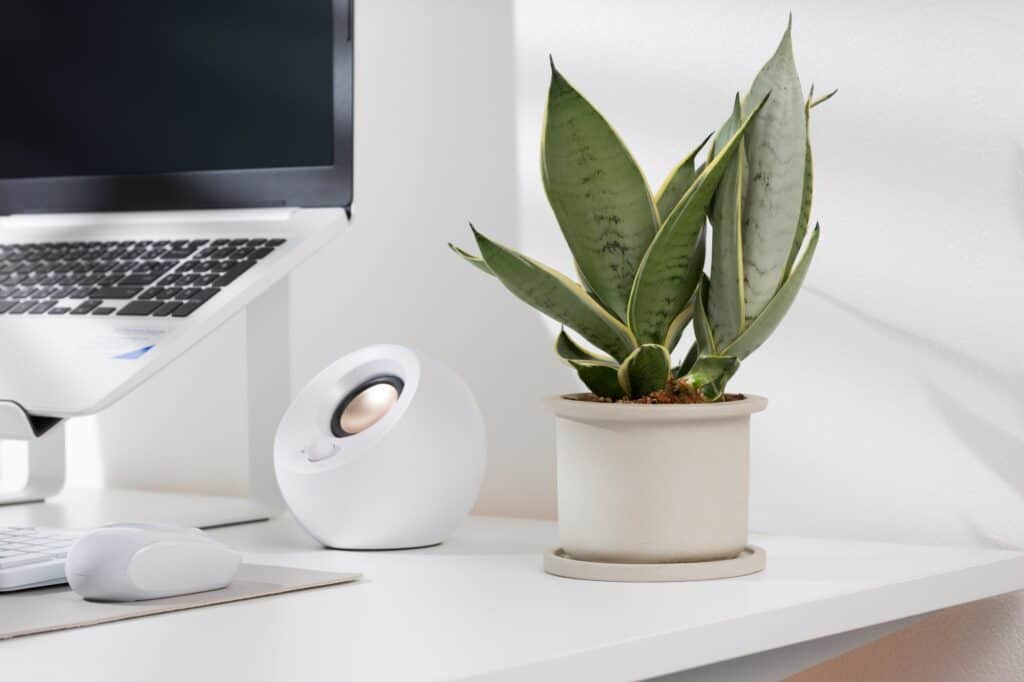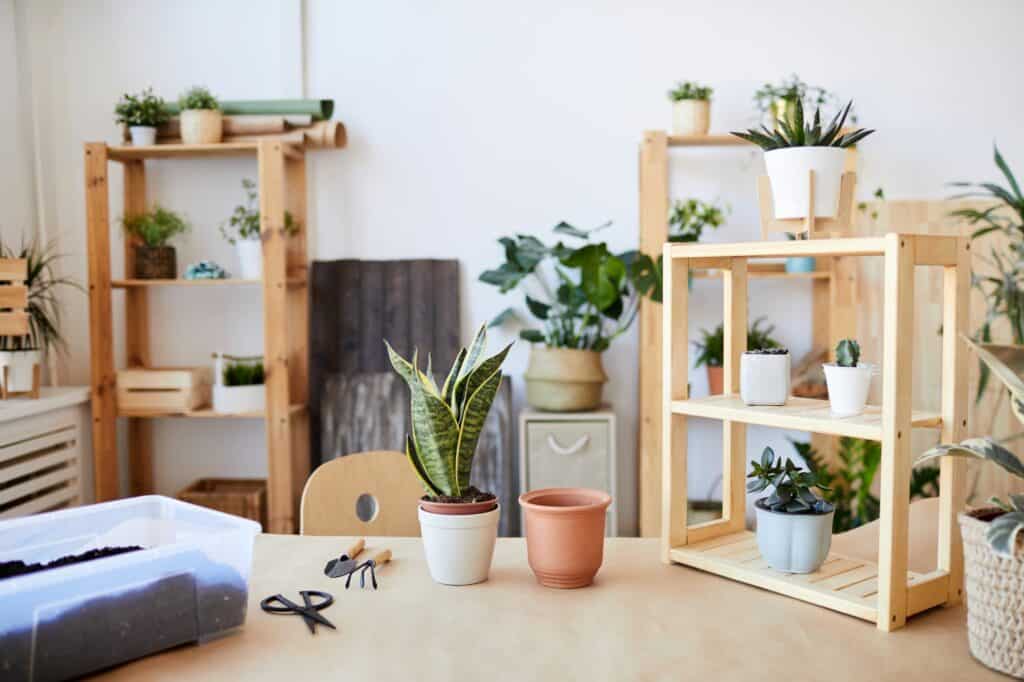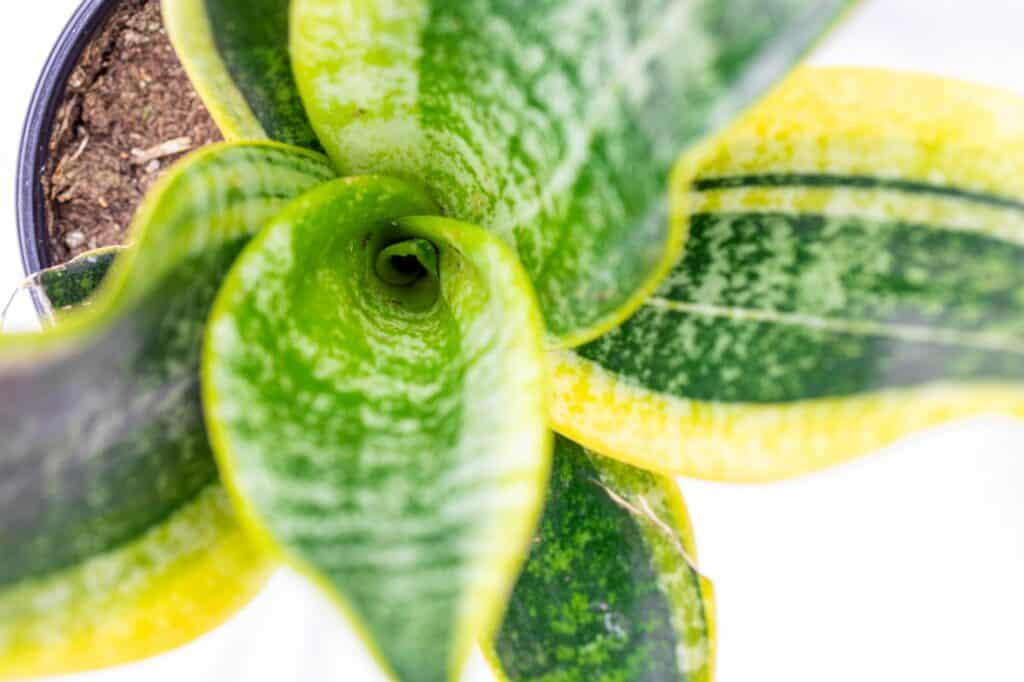When it comes to indoor plants, the snake plant (Sansevieria) is a popular choice among plant enthusiasts. It’s known for being low maintenance and easy to care for, making it a great option for beginners.
However, like any plant, it requires the right amount of water to thrive. Underwatering is a common issue that can affect snake plants, and it’s important to know how to recognize the signs.
An underwatered snake plant may not look drastically different from a healthy one at first glance, but there are some physical symptoms to look out for.
For example, the leaves may appear wrinkled or have brown and dry edges. The plant may also have slow growth or the leaves may fall over.
Understanding these symptoms can help you diagnose the issue and take the necessary steps to revive your plant.
Key Takeaways:
- Underwatering is a common issue that can affect snake plants.
- Physical symptoms of underwatering include wrinkled leaves, brown and dry edges, slow growth, and falling over.
- To revive an underwatered snake plant, it’s important to adjust watering habits and provide proper care.
Read more about snake plants:
What Does a Dying Snake Plant Look Like?
Is My Snake Plant Dying? 5 Signs, Solutions & Best Care Tips

Recognising an Underwatered Snake Plant
An underwatered snake plant can be easily recognised by observing its leaves and soil. Here are some signs and symptoms to look out for:
Signs of an Underwatered Snake Plant
- Wrinkling and curling leaves: An underwatered snake plant will have wrinkling and curling leaves due to dehydration. The leaves may also become soft and bendable.
- Brown tips: The tips of the leaves may turn brown due to lack of water.
- Dry soil: The soil will be dry to the touch and may even pull away from the edges of the pot.
- Slow growth: An underwatered snake plant may show stunted or slow growth.
Symptoms of an Underwatered Snake Plant
- Falling over: As the plant dries up, it may start to fall over.
- Yellow or brown leaves: The leaves may start to turn yellow or brown and eventually fall off.
- Brittle roots and leaves: The roots and leaves may become brittle and break easily.
It is important to note that some of these symptoms may also be caused by other factors such as overwatering, pests, or diseases.
Therefore, it is important to carefully observe the plant and its environment to determine the underlying cause of the problem.
To revive an underwatered snake plant, it is important to rehydrate the plant by soaking the pot in water and providing adequate water in the future.
Adding peat, coco coir or pumice in the soil mix can also help increase its water holding capacity and improve soil drainage.

What Does an Underwatered Snake Plant Look Like
When a snake plant is underwatered, it can exhibit several physical symptoms that can help identify the problem. Here are some of the common symptoms to look out for:
- Leaves Condition
One of the most obvious signs of an underwatered snake plant is the condition of its leaves. The leaves may start to curl, droop, or wilt.
They may also become wrinkled or soft to the touch. In some cases, the leaves may turn yellow or brown and fall off the plant. Brown tips and edges are also common signs of underwatering.
- Root Health
Underwatering can also affect the health of the plant’s roots. When the soil is too dry, the roots can become damaged and start to rot. Root rot can cause the plant to wilt and droop, even if the leaves appear healthy.
To check the health of the roots, gently remove the plant from its pot and inspect the roots. Healthy roots should be firm and white, while rotted roots will be soft and brown.
- Soil Condition
The condition of the soil can also provide clues about whether a snake plant is underwatered. Dry soil is a clear sign that the plant is not getting enough water.
The soil may also be hard and compacted, making it difficult for water to penetrate. In some cases, the soil may pull away from the edges of the pot, indicating that the plant has not been watered enough.
It is important to note that some of these symptoms can also be caused by other factors, such as overwatering or pests.
Therefore, it is essential to carefully examine the plant and its environment to determine the cause of the problem. By identifying the physical symptoms of underwatering, you can take steps to revive your snake plant and restore it to health.
Causes of Underwatering
Underwatering is a common problem that can affect the health of a snake plant. It occurs when the plant does not receive enough water to meet its needs. This can happen due to a variety of factors, including:
Infrequent Watering
Snake plants are drought-tolerant plants that can survive with infrequent watering. However, if they are left without water for too long, they can become dehydrated and start to show signs of underwatering.
Poor Drainage
If the pot does not have a drainage hole or the soil is compacted, the water may not drain properly, leading to waterlogged soil. This can cause the roots to rot and the plant to become dehydrated.
Low Humidity
Snake plants are tropical plants that thrive in high humidity. If the air is too dry, the plant may not be able to transpire properly, leading to dehydration.
Temperature
Snake plants prefer temperatures between 60 and 85 degrees Fahrenheit. If the temperature is too low or too high, the plant may not be able to absorb water properly, leading to dehydration.
Container Size
If the pot is too small, the plant may not have enough room to grow and develop a healthy root system. This can lead to underwatering, as the plant may not be able to absorb enough water to meet its needs.
Potting Mix
The potting mix should be well-draining and contain materials like perlite, peat moss, or vermiculite. If the soil is too heavy or does not drain well, the plant may become dehydrated.
By understanding the causes of underwatering, it is possible to take steps to prevent it and keep your snake plant healthy.

Effects of Underwatering on Snake Plant Growth
Underwatering is one of the common problems that snake plants face. When a snake plant is underwatered, it can have significant effects on its growth and overall health. Here are some of the effects of underwatering on snake plant growth:
Stunted Growth
When a snake plant is underwatered, its growth can be stunted. The plant may stop growing or grow at a slower rate than it should. This is because the lack of water affects the plant’s ability to carry out photosynthesis, which is essential for growth.
Damaged Roots
Underwatering can also damage the roots of a snake plant. When the soil is dry, the roots cannot absorb water, which can cause them to dry out and become damaged. Damaged roots can affect the plant’s ability to absorb nutrients, which can further stunt its growth.
Brown and Dry Leaf Edges
One of the visible signs of an underwatered snake plant is brown and dry leaf edges. The lack of water causes the leaves to dry out and turn brown, starting from the edges. This is because the plant is trying to conserve water by reducing the surface area of the leaves.
Leaves Curling
Underwatered snake plants may have leaves that curl inwards. This is because the plant is trying to reduce the amount of water loss through transpiration. Curling leaves can also be a sign of other problems, such as low humidity.
Slow Growth
Underwatering can slow down the growth of a snake plant. The plant may stop growing or grow at a slower rate than it should. This is because the lack of water affects the plant’s ability to carry out photosynthesis, which is essential for growth.
Plant Death
If left untreated, an underwatered snake plant can die. When a plant is severely dehydrated, it cannot recover even with proper watering. The lack of water can cause irreversible damage to the plant’s tissues, which can lead to its death.
How to Revive an Underwatered Snake Plant
If you notice that your snake plant is underwatered, it’s important to act quickly to revive it before it becomes too damaged. Here are some steps you can take to save an underwatered snake plant:
Rehydration Process
The first step in reviving an underwatered snake plant is to properly rehydrate it. Move the plant to a shaded area and soak the pot in water for about an hour.
This will allow the roots to absorb water and rehydrate the plant. Be sure to drain the excess water from the pot before returning the plant to its original location.
Repotting Underwatered Snake Plant
If the roots of your underwatered snake plant are damaged, it may be necessary to repot the plant. Choose a pot that is slightly larger than the current one and has good drainage.
Fill the bottom of the pot with a layer of gravel or small stones to improve drainage. Repot the plant in fresh soil and water it thoroughly.
Adjusting Watering Techniques
To prevent your snake plant from becoming underwatered again, adjust your watering technique.
Use a watering can to measure the amount of water you give the plant and ensure it receives enough moisture.
A moisture meter can help you determine when the soil is dry and needs watering. Water your snake plant when the top inch of soil is dry to the touch.
It’s also important to avoid overwatering your snake plant, as this can lead to root damage and dehydration.
A good watering schedule is to water the plant once a week during the growing season and once every two weeks during the dormant season.
Supplying Nutrients
Fertilize your underwatered snake plant with a balanced, water-soluble fertilizer to supply it with nutrients. Apply the fertilizer once a month during the growing season.
Be sure to follow the instructions on the fertilizer package to avoid over-fertilizing, which can damage the plant.
By following these steps, you can revive your underwatered snake plant and provide the support it needs to thrive.
Remember to monitor the plant for signs of dehydration, such as drooping or brittle leaves, and adjust your watering technique accordingly. Using a terracotta pot can also help regulate moisture levels and prevent overwatering.

Preventing Underwatering in Snake Plants
Snake plants are hardy houseplants that require minimal attention, making them great for new plant owners.
However, they can still suffer from underwatering, which can cause the leaves to shrivel up and turn brown. To prevent this from happening, there are a few steps you can take.
Choosing the Right Pot
When selecting a pot for your snake plant, it’s important to choose one with drainage holes. This will allow excess water to escape, preventing the soil from becoming waterlogged.
A pot that is too large can also lead to overwatering, so choose a pot that is just slightly larger than the root ball.
Proper Soil Mix
The soil mix you use for your snake plant is also important. A well-draining soil mix will prevent water from sitting in the soil, which can lead to root rot.
A good soil mix for snake plants should contain peat, perlite, and sand. This will provide the plant with the nutrients it needs while allowing excess water to drain away.
Ideal Light Conditions
Snake plants prefer bright, indirect light, but can also tolerate low light conditions. Direct sunlight can scorch the leaves, so it’s important to place your plant in a location that receives sufficient light but is not in direct sunlight.
Appropriate Watering Schedule
One of the most important factors in preventing underwatering is proper watering. Snake plants do not require frequent watering and can actually thrive in drier conditions.
It’s important to allow the soil to dry out between waterings to prevent the roots from becoming mushy. When watering, be sure to water deeply and allow excess water to drain away.
By following these simple steps, you can prevent your snake plant from becoming underwatered and ensure it thrives in your home.
Remember to pay attention to the soil moisture level and provide sufficient light and nutrients from the soil. With a little bit of attention and care, your snake plant will be a beautiful addition to your home.
Frequently Asked Questions
What are the signs of an underwatered snake plant?
An underwatered snake plant will have wrinkling and curling leaves with brown tips due to dehydration. The plant will start to fall over as it dries up and may die if left in dry soil for long. Other signs of an underwatered snake plant include yellowing leaves, dry soil, and drooping leaves. If you notice these signs, it is important to take action quickly to revive the plant.
How can you save an underwatered snake plant?
To save an underwatered snake plant, move it to a shaded area and soak the pot in water to rehydrate it. Make sure to water the plant thoroughly, but avoid overwatering it. You can also add a layer of mulch to help retain moisture in the soil. Once the plant has recovered, make sure to water it regularly to prevent it from drying out again.
Should you cut the drooping leaves of a snake plant?
It is not necessary to cut the drooping leaves of a snake plant. Instead, focus on rehydrating the plant and providing it with the proper care to help it recover. As the plant recovers, it may shed some of its damaged leaves, but this is a natural process and should not be a cause for concern.
How often should you water a snake plant?
Snake plants are hardy and do not require frequent watering. In fact, overwatering can be more damaging than underwatering. It is recommended to water snake plants once every two to three weeks, or when the soil is completely dry to the touch.
What are the differences between overwatering and underwatering a snake plant?
Overwatering and underwatering can both be damaging to a snake plant, but they have different signs. An overwatered snake plant will have mushy, yellowing leaves and may have a foul smell due to root rot. On the other hand, an underwatered snake plant will have dry, wrinkled leaves with brown tips and may be falling over due to dehydration.
Can a snake plant recover from being underwatered?
Yes, a snake plant can recover from being underwatered if it is given proper care and attention. It is important to rehydrate the plant and provide it with the right amount of water and light to help it recover. With the right care, a snake plant can thrive and continue to grow for many years.

Hey, I’m Lisa and I’ve been an avid gardener for over 30 years. I love writing, talking and living in the garden! Feel free to connect with me on my socials below


